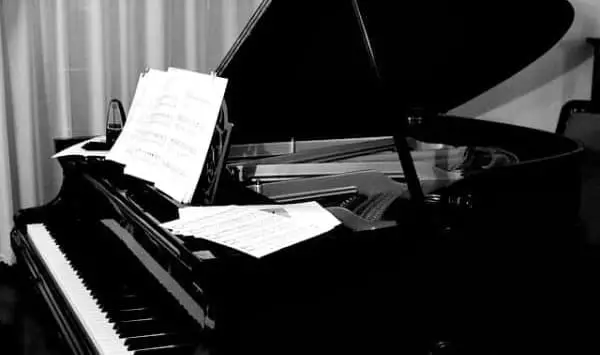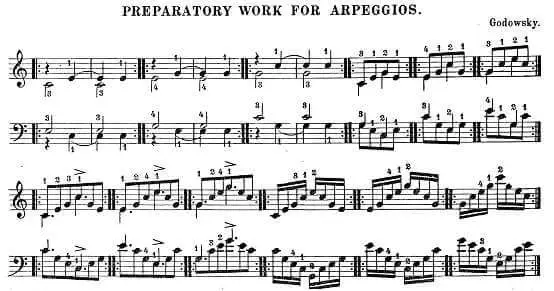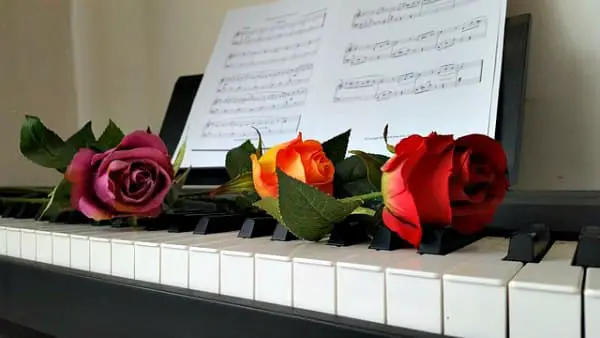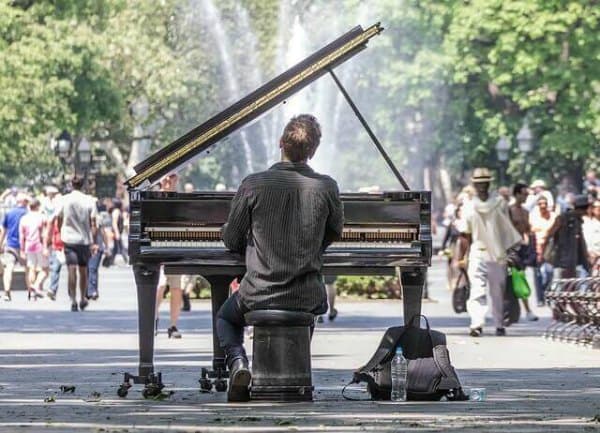- Home
- Piano Technique
- Piano Arpeggios
Practice Piano Arpeggios with Effective Exercises
This article may contain compensated links. Please read the disclosure for more info.
Learning and practicing piano arpeggios are part of an important exercise routine for all pianists. But what is the best way to practice them?
Here's a free piano lesson where you'll learn some effective piano exercises as well as get helpful practice tips to roll those arpeggios!
Below you will learn about fingering and get tips on how to practice arpeggios. You can also print free (PDF) exercises and sheet music with arpeggios.
Piano Arpeggios vs Broken Chords

so, what's the difference between broken chords and arpeggios?
Arpeggio note symbols
There is a way to write that a chord should be played "'arpeggiated" with note symbols. It's a way to "decorate" a chord by playing it broken; one note at a time.
 This is a Triad, a three note chord.
This is a Triad, a three note chord. A Triad that is played one note at a time, arpeggiated.
A Triad that is played one note at a time, arpeggiated.However, this is not the same as the technique of playing "arpeggios", which we'll work on here.
In classical piano technique, arpeggios and broken chords are studied as separate technical challenges:
- A broken chord is simply a chord played one note at a time, with no "thumb-under" movement.
- An arpeggio is a chord spread out over one or several octaves, using a "thumb-under" movement to pivot from one position to the next.
So, arpeggios are broken chords, but in classical piano technique they are chords played over a larger part of the piano keyboard. The name comes from the Italian word for harp; Arpa.
What you create when playing arpeggios is a harp-like sound by spreading out a chord, played note by note (or broken), over one or several octaves.
Different Technical Challenges
An arpeggio
is a broken chord too, but in classical piano technique, arpeggios and broken
chords are studied separately, since they have different technical challenges:
- Simple broken chords are practiced without any thumb under movement. For example, play C-E-G in the right hand with fingers 1-3-5, one at a time. This broken chord can be played in many different patterns and inversions and is easy to play.
- Arpeggios are played laterally, using the thumb-under motion to "pivot" from one position to the next. When you play the chord as an arpeggio over several octaves, for example C major: C-E-G-C-E-G-C, you use fingers 1-2-3-1-2-3-5. Now you have to make a fluid lateral movement with your arm, and your thumb needs to move under the palm of your hand.
This pattern can also be played in different ways and with inversions. Usually, this is what is called to play an arpeggio.
Playing large arpeggios like this needs more practice since it is harder to do.
A good book for your library is The Complete Book of Scales, Chords, Arpeggios & Cadences. It gives you all you need and is a good reference book that all serious pianists should have.
However, after all is said and done... broken chords are arpeggios, and arpeggios are broken chords! : }
It's like etudes and exercises- they mean the same thing but the names are used as a description of different types of piano playing technique. Etudes are more like piano pieces, and exercises are more like technical exercises.
How to play piano arpeggios fluently
The difficulty for pianists when playing arpeggios over several octaves is to make the sound even and fluid.
Since you have to move your hand using the thumb-under motion and move your arm laterally, the difficulty is to avoid making “jerky” movements.
For smooth playing, it is first of all important to use correct fingering. This makes it easier for the hand to move as fluid as possible.
Basic Rules for Piano Arpeggios' Fingering
If You Don't Like Rules...
the “rules” are not there to be nasty... they are there to help with the best comfort in the hand when stretching out the fingers, and so that you can play as fast and effortless as possible!
- Avoid using the thumb on the black keys. The exception is when all the keys are black in the arpeggio (like Gb). Then the thumb may be used on a black key too.
- If the arpeggio has only one white key- this is where the thumb is used!
- The fingering in the left hand will change slightly. When there is one white key between the first and the second key in the chord, use fingers 5-4-2-1. When there are two white keys, use fingers 5-3-2-1.
6 groups of piano arpeggio patterns
There are 12 major and 12 minor triads (3 note chords). In the root position, where notes are spaced only thirds apart, they can be organized in 6 groups of black and white key patterns.
Tip: If you practice all arpeggios in each group at a time, you'll learn the patterns faster!
Here are the groups: (W=White key, B=Black key)
- Group 1: Only white keys (W-W-W): C, F, G, Dm, Em, Am.
- Group 2: White with a black middle key (W-B-W): D, E, A, Cm, Fm, Gm.
- Group 3: Black with a white middle key (B-W-B): C#/Db major and minor, D#/Eb, F#/Gb, G#/Ab major and minor.
- Group 4: Only black keys (B-B-B): F#/Gb, D#/Eb minor
- Group 5: One white key and two black (W-B-B or B-B-W): B, Bbm.
- Group 6: One black key and two white (B-W-W or W-W-B): Bb, Bm.
Piano arpeggio fingering (Root position) for each group
Right hand:
A. With the right hand use fingering: 123 1235
For the following triads (Groups 1, 2, 4, 5, 6):
- Major: C, F, G, D, A, E, B and F#/Gb.
- Minor: C, D, D#/Eb, E, F, G, A, B
B. Use fingering: 412 4124
For the following triads (Group 3):
- Major: C#/Db, Eb, Ab, Bb
- Minor: C#/Db, F#, G#/Ab
C. Use fingering: 231 2312
- For Bb minor only.
Left hand:
A. With the left hand use fingering: 542 1421
For the following triads (Groups 1, 2, 4):
- Major: C, F, G
- Minor: C, D, D#/Eb, E, F, G, A, B
B. Use fingering: 532 1321
For the following triads (Groups 2, 4, 5):
- Major: D, A, E, B and F#/Gb.
C. Use fingering: 214 2142
For the following triads (Group 3):
- Major: C#/Db, Eb, Ab
- Minor: C#/Db, F#, G#/Ab
D. Use fingering: 321 3213
For the following triads (Group 5, 6):
- Major: Bb
- Minor: Bb
Exercises for piano arpeggios
Here are some really great thumb exercises to use before playing arpeggios.
They will help “loosen up” your thumb and give greater security when making lateral changes.
Regularly practicing these exercises will also make it easier to play arpeggios fast.

(From a text in the public domain. To download the free complete pdf, go here.)
Piano arpeggios free pdf
Here you can print FREE the piano arpeggios from Hanon's "The Virtuoso Pianist" in all major and minor keys (PDF) (Opens in a new window).
Please note that you need to skip ahead to exercise nr. 41 for the arpeggios!
To avoid emphasizing the thumb, the patterns are written in four-note groups.
Piano sheet music with arpeggios
Broken chords are easy to find in numerous compositions. Arpeggios are used in etudes and in some piano repertoire, but usually on more advanced levels.
Czerny wrote a few etudes that are not too hard but still use a lot of arpeggio movements. You can get all of Czerny’s op.849 in a good edition here: Czerny Etudes op. 849. I suggest you start with the Etude nr. 15, it is a very nice etude with lots of arpeggios for both hands. And a great workout!






